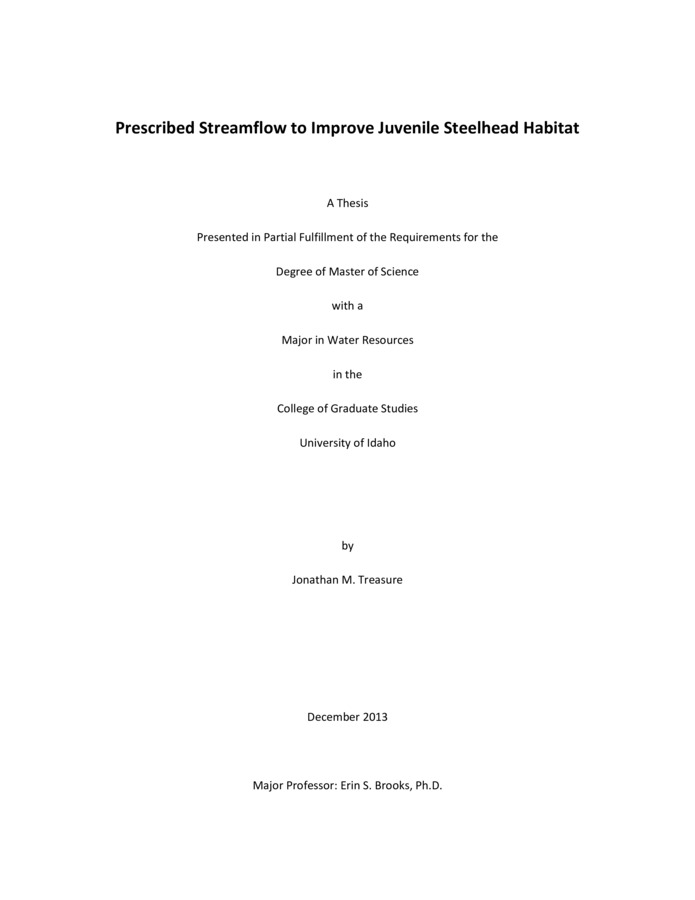Please note: this collection is no longer updated. Visit our Theses and Dissertations Collection in VERSO for all U of I ETD since 2012.
ETD PDF
Prescribed Streamflow to Improve Juvenile Steelhead Habitat
Citation
Treasure, Jonathan Michael. (2013). Prescribed Streamflow to Improve Juvenile Steelhead Habitat. Theses and Dissertations Collection, University of Idaho Library Digital Collections. https://www.lib.uidaho.edu/digital/etd/items/etd_407.html
- Title:
- Prescribed Streamflow to Improve Juvenile Steelhead Habitat
- Author:
- Treasure, Jonathan Michael
- Date:
- 2013
- Keywords:
- Baseflow Augmentation Dissolved Oxygen Distributed Hydrologic Model Steelhead Waste Water Water Resources Education Water resources management
- Program:
- Environmental Science
- Abstract:
- Summer baseflows are declining across the Pacific Northwest as a result of earlier spring snowmelt events and decreasing snowpack. These flows are critical to maintain suitable rearing habitat for many salmonid species. In Troy, Idaho, effluent waters from the city waste water treatment plant have been documented to support perennial flow conditions maintaining 6 km of salmonid rearing habitat. Despite low dissolved oxygen concentrations created from instream nitrification of ammonia in the effluent, the highest juvenile steelhead densities in the Potlatch River Basin are found within this effluent dominated stream. The objectives of this study were to monitor water quality conditions as a response of summer baseflow augmentation upstream and downstream of an effluent discharge point, quantify instream losses and create a reservoir management plan to improve salmonid summer rearing conditions. Instream losses were determined per habitat reach as well as the total distance of 10 km between Big Meadow Reservoir, a municipal drinking water supply, and the effluent point. A release of 0.21 cfs maintained 100% habitat connectivity for 10 km and kept water quality conditions upstream of the effluent point in compliance with state standards for cold water biota, a beneficial use of the system. While dissolved oxygen concentrations of effluent receiving waters improved, summer baseflow augmentation is not a feasible solution to keep effluent receiving waters in compliance with state standards. Model results indicate 100% habitat connectivity and a non-effluent dominated system can be achieved through a baseflow augmentation campaign 5 out of 10 years under 50% less reservoir consumption and 7 out of 10 years with 70% reduction of reservoir consumption concurrently maintaining 25% of the reservoir as backup reserves for the city. Model results under downscaled Representative Concentration Pathways (RCP) 4.5 and 8.5 trajections and modest population growth over the next 30 years suggest that 65% reduction in reservoir consumption would permit baseflow augmentation feasibility 5 out of 10 years. An investigation was pursued to examine the best methods for promoting water conservation. As a result, an example proposal focusing on middle school education was established highlighting the value of teaching science with a holistic systems perspective in an immersive gaming environment (i.e. a video game). This application based approach may improve student motivation to dive into the fundamentals of scientific subjects and promote scientific disciplines as a potential career choice.
- Description:
- Thesis (M.S., Environmental Science)--University of Idaho, December 2013
- Major Professor:
- Erin Brooks
- Type:
- Text
- Format:
- application/pdf
Rights
- Rights:
- In Copyright - Educational Use Permitted. For more information, please contact University of Idaho Library Special Collections and Archives Department at libspec@uidaho.edu.
- Standardized Rights:
- http://rightsstatements.org/vocab/InC-EDU/1.0/

